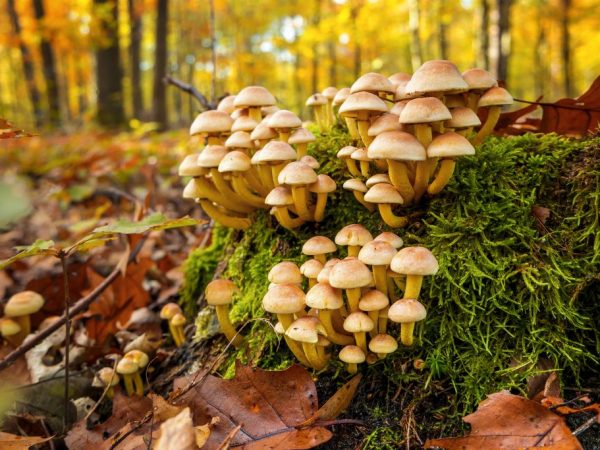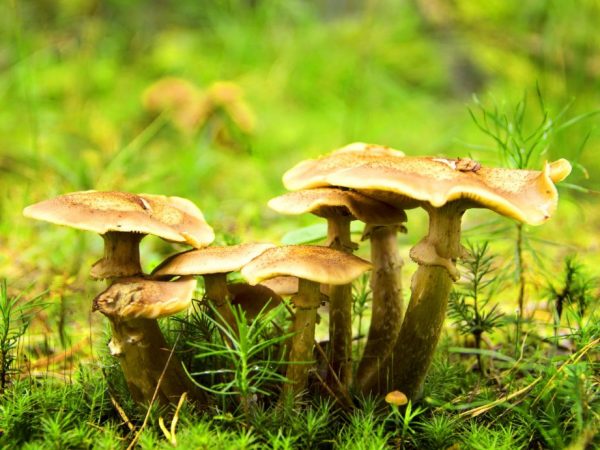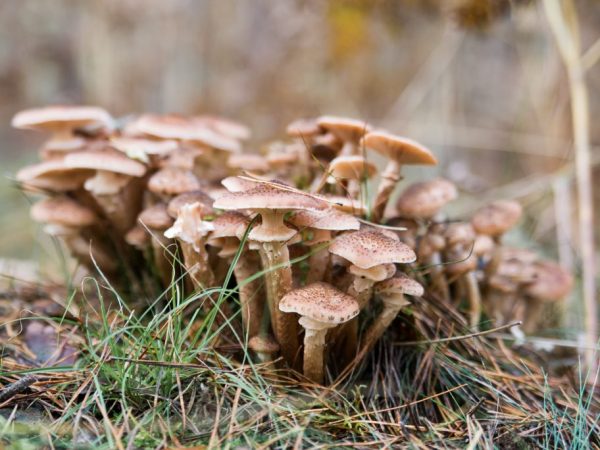Autumn mushrooms
Mushrooms in the forests of Russia amaze with their diversity. They grow in all its regions. Fans of "quiet hunting" with great pleasure spend their time in the cool thickets, where the whole families of autumn mushrooms grow on stumps and fallen trees in one place. They are good because different processing methods are suitable for them: drying, frying, freezing, etc.

Autumn mushrooms
Description of autumn mushrooms
Healthy autumn mushrooms appear at the end of August and delight with their taste until the first frost. A whole family is located on one mossy stump, from which it is easy to prepare several dishes.
Armillaria mellea, Armillaria autumn mushrooms, belong to the Physalacrium family. Otherwise, they are called "real honey".
Translated from Latin, the word Armillaria means "bracelet". The name is associated with how it grows - it encircles a stump or a fallen tree trunk in the form of a bracelet ring.
Irina Selyutina (Biologist):
It is often said that two species are hidden behind the common name "autumn mushrooms" - autumn honey mushroom (Armillaria mellea) and northern autumn mushroom (Armillaria borealis). Studies have shown that these species can be distinguished only on the basis of microscopic studies of their hymenium (spore-forming layer). The differences are that at the base of the northern mushroom basidia there is a buckle, and at about. honey she is missing. Also, these species are distinguished by their ranges: o. honey is found in the southern regions, about. autumn northern - in the northern regions of Russia. But in temperate latitudes - there are representatives of these two species.
Rainy October is their favorite month. On rotten stumps, small droplets-caps appear, which quickly turn into adult hemp mushrooms.
Honey mushroom appearance:
- lamellar cap, thin;
- the color of the cap varies from yellow to brown;
- the shape of the cap is slightly convex;
- hymenophore plates whitish or gray;
- the leg is long and thin;
- the color of the leg can be from light beige to dark gray.
According to the description, the older the autumn mushrooms are, the less noticeable the bulge on their caps is. It gradually becomes flat, thinned towards the edges and with slightly noticeable stripes. Its size is small (3-15 cm).
The plates under the cap are adherent, thin and whitish. With age, they darken and a spore powder forms on their surface.
The leg is thin, up to 5-18 cm high (in overgrown specimens up to 23 cm), 0.5-2.5 cm in diameter. It is dense, cylindrical in shape, with a thickening downward. In young organisms, it is fibrous, in older organisms it becomes smooth and naked. It gradually becomes tough and that is why only the caps are removed when harvesting.
On the leg there is a characteristic "skirt" -ring, under which small scales are visible. The pulp is homogeneous, firm and white. The color does not change on the cut. The taste is pleasant, the aroma is characteristic, rich.
Winter species have the same characteristics as autumn ones.
Varieties
The edible honey agaric family has more than 40 species. These include birch, meadow, yellow, Uspensky, Chinese, thick-legged, winter, summer, autumn, red, dark, etc. They differ in their location, in shaded forests or open meadows, in the grass or at the foot of different trees.
They are late, winter, hemp, birch, edible and inedible, overgrown and young, etc. Any of them has its own properties and qualities.
Before going for the harvest, it is important to find out which of them are well disguised as edible, how they look, so as not to get poisoned. For advice, it is better to turn to mushroom pickers with experience - they will not refuse to show what real edible and inedible mushrooms look like.
Description of conditionally edible, false mushrooms:
- spore plates are bluish;
- the body is bright yellow;
- a hat with yellow or gray;
- there are no scales on the leg.
It is more difficult to prepare such a fruiting body than an edible one. It is soaked for several hours, washed in running water, boiled and then cooked according to the basic recipe. In order not to risk it, it is better not to collect such suspicious forest organisms: health is more expensive.
Meadow, meadow mushroom or clove mushroom

Collect only edible mushrooms
According to the description, the meadow or carnation mushroom (Marasmius oreades) belongs to the genus Negnichnik of the family Negnichnikovye. It is a soil saprophyte that usually grows in meadows, fields, forest edges, along the edges of roads and in summer cottages.
During fruiting, it forms a kind of arcs, grows in "witch circles".
Appearance:
- the leg is thin, up to 10 cm in length and 0.2-0.5 cm in diameter;
- the cap is initially convex, then becomes almost flattened;
- the color of the cap is yellowish brown;
- the color of the leg is beige-yellow;
- plates are rare;
- the pulp is light.
A characteristic feature of the meadow is the absence of a "skirt" on the leg. The scent resembles clove, which is the basis for its synonymous species name - clove mushroom. The time of its collection is from May to the first days of November. In appearance it is similar to Collybia dryophila and conditionally edible meadow biotope. The difference lies in the unpleasant odor and the presence of frequent plates.
To the poisonous counterparts of the meadowsweet belongs the whitish Govorusha (Clitocybe dealbata). They differ only in their caps. The double's hat is not yellow or beige, but with a whitish bloom and without a tubercle.
Thick-legged honey agaric
Fat-legged honey fungus (Armillaria gallica) from the genus Openok, belongs to the Physalacrium family. They grow on fallen trees (more often on beech and spruce) and, as a saprophyte, is found on fallen leaves.
Appearance:
- the leg is straight, not very high, with a tuberous thickening at the base;
- the color of the leg is lighter than the color of the cap;
- the ring is pronounced, white, in the upper part of the leg;
- a hat with a diameter of 3 to 10 cm;
- there are frequent scales in the center of the cap;
- the flesh of the cap is light, mushroom aroma;
- the pulp of the leg is tough, fibrous.
The shape of the cap in young organisms is conical, widened downward, while in old organisms it becomes flat and flattened. "Skirt" - cobweb.
Udemanciella mucosa
Oudemansiella mucous, otherwise white slimy honey fungus (Oudemansiella mucida), is a rare species. Its representatives settle on the wood of fallen trees, more often beeches, or parasitize on trees that are still alive, but damaged. Its description is characterized by:
- leg up to 8 cm long and up to 0.4 cm in diameter;
- the color of the leg is brown;
- the ring is thick and slimy;
- the shape of a young cap is conical;
- olive pulp;
- plates are rare;
- the color of the plates is yellow;
- does not have a strong taste and aroma.
The caps are large, with dry skin. With age, changes in appearance occur. The pulp becomes slimy and whitish. The base becomes brownish, and the cap becomes flat. It is better to look for them in deciduous forests.
Uspensky mushroom

Honey mushrooms are very useful for the body
The name "Uspensky" got its appearance on the Christian holiday of the same name: the Dormition of the Most Holy Theotokos.On these days, its collection begins and continues intensively for another 2 weeks, after which it begins to decline. But with good autumn weather, the harvesting season drags on almost until November.
Irina Selyutina (Biologist):
Assumption mushrooms first appear on birches or birch stumps. Initially, their size does not exceed the size of a pinhead, but after 2-3 days you can already harvest a good harvest. These mushrooms can be perfectly transported in any container. But it is important to withstand one condition - to quickly deliver them home so that they do not "burn out" and scatter in a thin layer on a flat surface. When collecting honey agarics, it is advisable not to forget that if mushrooms are picked in rainy weather, they will quickly lose their attractive appearance, which, however, will not affect the taste and aroma at all.
Uspensky mushrooms have a thin yellow-brown cap, slightly convex in the center and lamellar on the back. It is kept by a thin beige-brown leg, up to 9-10 cm long. A characteristic ring and scales under it are visible on the leg.
Beneficial features
These forest organisms have gained their popularity quite deservedly. It is easy to pick up a full basket of healthy treats from one stump, which is considered low-calorie and has a number of essential vitamins and minerals:
- phosphorus;
- potassium;
- fiber;
- amino acids;
- proteins;
- vitamins B, C, PP, A and E.
In terms of the set of nutrients, they are superior to fish. They have a tonic effect on the entire body. With anemia, they promote the process of hematopoiesis. 100 g of autumn mushrooms will replenish the daily intake of trace elements in the human body.
The amount of micro- and macroelements present in them "rolls over" when compared with the norm necessary for the normal life of the human body:
- Fe (daily requirement - 4.3 mg) - 0.82 mg;
- K (daily requirement - 16.5 mg) - 410 mg;
- Ca (daily requirement - 0.51 mg) - 5.0 mg;
- Mg (daily requirement - 5.1 mg) - 21 mg;
- Na (daily requirement - 0.41 mg) - 5.0 mg;
- P (daily requirement - 5.65 mg) - 46 mg.
In 100 g of the product, the amount of organic matter is as follows:
- proteins - more than 2 g;
- fats (saturated and polyunsaturated) - 0.3 g;
- fiber or dietary fiber - about 3 g;
- simple carbohydrates - more than 0.25 g.
For vegetarians and vegans, they are indispensable for replenishing the body with potassium and calcium. Honey mushrooms are effective in the prevention of diseases of skeletal tissue along with dairy products.
Harm and contraindications
Honey mushrooms contain chitin, most of which is present in the legs. It has a negative effect on the digestion process. Therefore, these mushrooms are not recommended for people with gastrointestinal problems, peptic ulcer disease or gastritis. Abuse leads to a way out of remission and exacerbation of processes.
Heavy food is not recommended for children under 12 years of age. Pediatricians advise against taking risks and adding mushroom dishes to the children's diet.
It is better for pregnant women and people with individual intolerance to avoid such products and replace them with more familiar ones.
Application
Forest mushrooms, in particular honey mushrooms, are carefully studied by biologists and physicians. They are successfully used in various areas of modern life: in cooking, medicine, pharmaceuticals and cosmetology.
Application in medicine and pharmaceuticals
They kill bacteria and viruses, therefore they are used to create antiviral drugs and antibiotics, based on the active substances present in their fruit bodies.
Doctors prescribe medications containing their constituents to people with high blood pressure (hypertension) to reduce and stabilize it.
With regular consumption of these mushrooms, the metabolism is restored and the work of the circulatory system is stimulated. Doctors prescribe them as a therapeutic food for people with thyroid diseases.
For people suffering from chronic constipation, autumn mushrooms serve as a natural laxative.
It has been noticed that these late mushrooms are able to lower blood sugar levels and remove "bad" cholesterol from the blood.
Application in cosmetology
The small caps of these mushrooms contain a large amount of retinol, which cosmetologists successfully use in their work. Extracts and tinctures are made from the fruit bodies, which strengthen the hair. In the fight against skin aging, creams are used, which are based on retinol and vitamins A and E.
Cooking applications
Culinary experts love these wild mushrooms for their ease and variety of preparation. Snacks and pates from these mushrooms are obtained with a unique aroma. They add special piquancy and originality to the first courses. Pickled mushrooms are in special demand. However, do not forget that:
- Poorly cooked (for example, undercooked) mushrooms can cause kidney and liver problems.
- it is necessary to strictly adhere to all sanitary standards during their conservation, so that even the smallest particles of dirt do not get into the banks - they can provoke the development of botulism pathogens in favorable conditions and, as a result, cause human death.
Conclusion
Walking through the forest to pick mushrooms will be of practical benefit. It is important to be careful - in order not to take risks, it is better not to cut off unfamiliar varieties.



